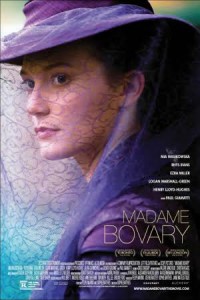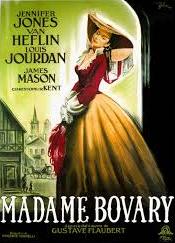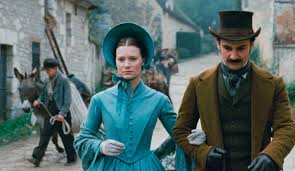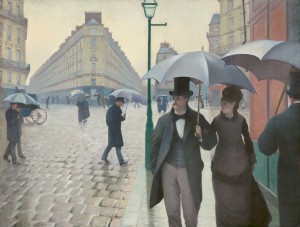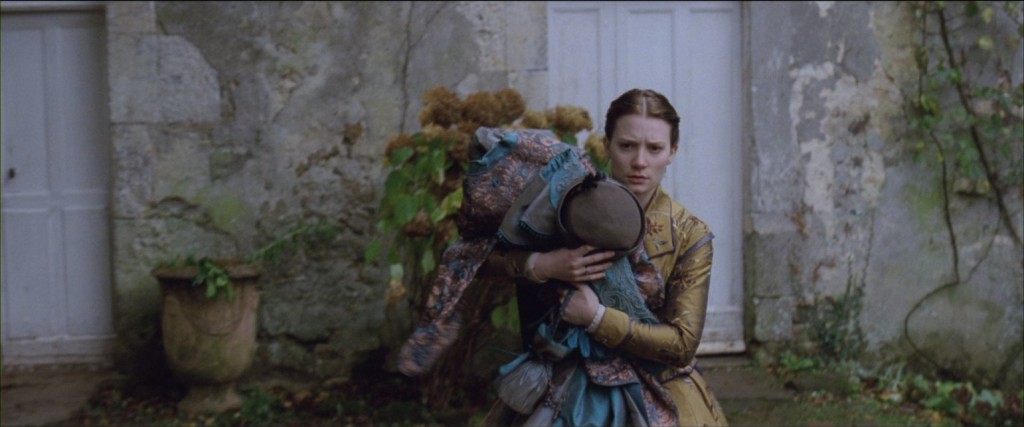James Smith Allen
Southern Illinois University Carbondale
In Gustave Flaubert’s novel, Emma Bovary dies in a crowded bedroom, a scene worthy of social historian Philippe Ariès’s description of such final moments as they changed over time.[1] Besides her husband Charles, the distraught and disheveled Emma is surrounded by Yonville’s parish priest Boursinien, Emma’s devoted domestic servant Félicité, the ambitious pharmacist Homais and his two sons, and the physician Canivet from Neufchâtel. The renowned Doctor Larivière has just departed, unable to help the dying patient. Emma’s little girl, Berthe, also makes a brief appearance, mistaking the extra candles and the crowd for a New Year’s or mi-carême celebration. Finally, after Bournisien’s ministration of the last rites, the town’s blind beggar sings a scandalous ditty on the sidewalk below the bedroom window. “Then Emma began to laugh, a dreadful, frantic, desperate laugh, convinced she saw the wretch’s hideous face rising before her in the eternal darkness like a terrifying warning.”[2]
 How different is Emma’s death scene in Sophie Barthes’s cinematic version! We witness a young woman (Mia Wasikowska), impeccably dressed in a smartly stitched silk jacket and matching skirt, faltering at a slow trot along a desolate wooded path. There is no one else in sight. The autumn forest has changed its colors to a soft reddish brown. Besides Emma’s labored panting, the only living sounds are the birds twittering in the background as the bouncing camera captures Emma’s disordered mental state. She pauses a couple of times until at last she can no longer withstand the pain in her midriff; she sinks to her knees and falls gently on her side, a medicinal vial visible in her open hand. With a few last breaths, she dies, her clothes neatly arrayed around her in a textured complement to the fallen leaves that serve as her penultimate resting place. Not a single word – or laugh – is offered in her last moments. So starts and ends the movie.
How different is Emma’s death scene in Sophie Barthes’s cinematic version! We witness a young woman (Mia Wasikowska), impeccably dressed in a smartly stitched silk jacket and matching skirt, faltering at a slow trot along a desolate wooded path. There is no one else in sight. The autumn forest has changed its colors to a soft reddish brown. Besides Emma’s labored panting, the only living sounds are the birds twittering in the background as the bouncing camera captures Emma’s disordered mental state. She pauses a couple of times until at last she can no longer withstand the pain in her midriff; she sinks to her knees and falls gently on her side, a medicinal vial visible in her open hand. With a few last breaths, she dies, her clothes neatly arrayed around her in a textured complement to the fallen leaves that serve as her penultimate resting place. Not a single word – or laugh – is offered in her last moments. So starts and ends the movie.
The contrast is no accident. Clearly, no cineaste of Barthes’s independent vision is bound to an artistic form other than her own. The driving force behind two previous films, Happiness (2004) and Cold Souls (2009), Barthes knew precisely what she was doing in her reconstruction of Flaubert’s famous novel. Film and literature are two different modes of expression that borrow from each other, to be sure, but are in no way beholden to one another. They have their own rhetorical conventions and traditions, their own creators, critics, and historians, and their own purposes, ethos, and integrity. Consequently, when a film is “based on” a novel, there must be accommodations, if only to compress several hours of reading – many more if the reading is aloud – into rarely more than 100 minutes of viewing time (in the present case 118). Whole scenes, characters, and settings in prose are omitted to compress the narrative into manageable cinematic form. But the cineaste can and wants to do more – to introduce a sound track and lingering vistas without language, for example – than a novelist, whatever storyline they may share. History, we know, owes much to prose realism, but there’s a good reason why Hayden White did not include film in his categories of historiographical styles.[3]
Barthes follows in a long line of cinematic attempts to make over Flaubert’s account of a deluded woman who, deeply disappointed in love and unable to pay off huge debts, commits suicide. The uninspiring men in her life include an unimaginative dolt of a husband, Charles, a small-town doctor with whom she has an annoying daughter; they are hardly the making of the connubial bliss that Emma read about in the romantic novels she devoured: “It was all above love, lovers, and persecuted ladies fainting in isolated garden pavilions.”[4] Swept away from ethereal dreams to the drab reality of provincial life during the July Monarchy, Emma seems to find amorous promise in a young law clerk, Léon Dupuis; he leaves to study in Paris before much comes of it. After an elaborate ball at Vaubyessard (the neighboring marquis’s château), she meets a prosperous local squire, Rodolophe Boulanger, who dallies with her for four years. Rather than run away together as planned, Rodolphe breaks off their affair, leaving Emma deeply shaken. She is relieved to rediscover Léon at the opera in Rouen; they carry on an affair of their own until Emma’s bills with a merchant, supplying her credit to buy whatever she wanted, come due. Without resources other than Léon who ends their relations and Rodolphe who refuses her pitiful appeal for money, Emma solves her dilemma in a melodramatic turn: she swallows arsenic. True to form, her forgiving husband dies of grief.
This plot of passion wasted on unworthy characters is the unremarkable basis for a great novel. Its achievement lies not in the sad tale of love gone awry in the Norman countryside, but in Flaubert’s meticulously crafted text, which featured an expository innovation, the free indirect style. The narrator disappears from the usual places where one would expect him to comment on the action. Celebrating the author’s detachment from his work – “The artist must be in his work like God in Creation, invisible and omnipotent, his presence must be felt everywhere but remain unseen”[5]– Flaubert introduced a form of realism that is judgment-free other than the occasional sarcasms of a writer’s barely noticeable presence. The narrative neither condones nor condemns the characters, their doings, or their settings, and this unsettled Flaubert’s original audience when his book was first serialized in the Revue de Paris in 1856. Baffled and infuriated, the authorities hauled the novelist to court for “offenses against public morality and religion.”[6] In a major victory for literature, the court sided with the author, the owner and printer of the magazine, creating a succès à scandale that guaranteed the work’s subsequent sales and led critics, in time, to reconsider the nature of its literary merits.
Historians have made much of the world depicted by the novel; cineastes regarded it as an invitation to film. There have been no fewer than 18 adaptations of this work, beginning as long ago as Albert Ray’s imaginative variation, Unholy Love (1932), set in Rye, New York, with an entire cast of renamed characters. In 1934, at his distributor’s insistence, Jean Renoir trimmed nearly half the length of a rendition truer to the novel. The release, a theatrical homage to his father, the painter Auguste Renoir, is a better-known if not more successful refashioning of the novel. Two other productions – one directed by Vincente Minnelli in 1949, starring the radiant Jennifer Jones; the other directed by Claude Chabrol in 1991, featuring the imposing Isabelle Huppert – are the versions most used in the college classrooms studying Flaubert’s work.[7]
Minnelli takes notable liberties with the book – Flaubert becomes the narrator in a departure from the author’s actual ironic distance – while Chabrol is much more faithful to the text – voicing-over select passages from the work – even as Huppert’s curious stepping in and out of her role introduces a striking inconsistency lamented by numerous critics. Besides productions in seven languages other than French and English, television directors have ventured adaptations, including Jean Sherrard’s National Public Radio Playhouse production in 1986 and Tim Fywell’s Masterpiece Theatre’s in 2000. None of these non-cinematic efforts, however, is altogether suitable for comparison with Barthes’s work.[8] Like linguistic differences between French and English, much is lost in translation.
What can the historian make of this film? One is tempted to point out numerous inaccuracies in the carefully chosen setting of Normandy, such as the gracefully symmetrical cathedral serving as the backdrop to the park where Léon Dupuis (Ezra Miller) hails the carriage to take him and Emma on Flaubert’s scandalously detailed journey to an afternoon of lovemaking; but such a cathedral is nowhere to be found in Rouen. Emma refers to her servant Henriette, a.k.a. Félicité (Laura Carmichael) as having a “profession” (métier or état), which in the 1840s would more likely have been her “rank” (rang) or “station” (station).[9] An historian would also question the relative ease with which this married woman was able to sign legal documents on behalf of her husband, setting in motion the later proceedings against Charles Bovary (Henry Lloyd-Hughes); the novel is much more forthright about the chicanery of the procuration. It is almost unimaginable that a town the size of Yonville (the fictionalized site of Ry in the Seine-Maritime) would have inhabitants passing each other without a sign of recognition; the alienation of the neighbors in Barthes’s film, purportedly set in rural Normandy during the reign of Louis-Philippe, resembles the feigned indifference of pedestrians in contemporary Paris.
Similar discrepancies between novel and film are easy to identify. Perhaps the most remarkable is the substitution of the Marquis d’Andervilliers’s hunt for the Vaubyessard ball. It is almost is if Barthes is acknowledging that she could not improve upon Minnelli’s dizzying dance scene set to Maurice Ravel’s demonic “La Valse,” much less Chabrol’s shift of view from the dancers’ faces to their feet, and so she invents a visually daring and symbolic quest on the Marquis’s part to slay a stag with a single thrust of his sword in the very woods where Emma would later die, a vanquished prey of another sort. Moreover, Barthes conflates the Marquis d’Andervilliers (Logan Marshall-Green) and Rodolphe Boulanger. In the film Emma bears no child, though towards the end, as her life falls apart, she smiles regretfully at a mother nursing her infant. The opera scene in Rouen is replaced by a chamber concert. Charles is a less stolid, unthinking character than his counterpart in the novel. Barthes’s Homais (Paul Giametti) hardly utters an anticlerical word in the presence of the priest Bournisien (Richard Cordery). The fatuous speeches at the agricultural fair –a celebrated instance of Flaubert’s corrosive irony—cannot be heard through the closed, upper-story windows overlooking the dais where an old, deaf servant is publicly honored: “Fifty-four years of service! A silver medal! Twenty-five francs!”[10] One could go on.
The differences between literature and film underlie these omissions, and require some analysis of why Flaubert’s Madame Bovary is so very hard to transpose to the screen. After making reference to Chabrol’s film, Barthes stated in an interview, “I wanted to make a film that would [be] as aesthetic as possible and to capture the atmosphere of Normandy the most authentically that we could. Some of the greatest French painters came from Normandy – the light is extraordinary.”[11] So the novel was not the only medium Barthes had in mind as she framed her screenplay and filmed on location. In sharp contrast to Flaubert’s commitment to language, Barthes is focused on the visual, the scenic, the artistic, the “aesthetic” as she emphasized in the interview. Every frame is carefully, deliberately composed as if it were a painting whose color, line, form, and depth, and are intended more for an exhibition than for a movie whose other elements – the plot, the characters, the dialogue, the soundtrack are generally of principal interest. If Emma is the chief protagonist in the film, it is in large measure her pictorial qualities – her clothes, her furnishings, her gestures, her face and body – that captivate the viewer. Barthes seems to have selected Wasikowska because of her embodiment of this sensory specificity: “She is enigmatic on screen and the camera loves that. Her intelligence and complexity just [come] to the surface, so you could just simply watch her reading the yellow pages and it would be interesting! I think she is fearless at embracing complicated, controversial, morally condemnable characters.”[12]
Wasikowska’s Emma Bovary stands out for more than the brightly colored, stylish clothes she wears in the film. This actress’s interpretation is less emphatic, more nuanced. Here Emma’s mysterious inner self contrasts sharply with her striking poses and appearances among the decidedly drabber figures around her. She is driven less by the reader’s fantasies alluded to in the novel – Wasikowska’s Emma merely looks at the illustrations in the fashion journals that the merchant draper Lheureux (Rhys Ifans) sells her – than she is by the illusions made possible by consumer culture. Bored and offended by the limitations, pettiness, and banalities of bourgeois life, this Emma grabs what distinction she can in her possessions – on her body, in her home, with her lovers. Only toward the end of the film, as the consequences of her fashionable infatuations close in on her, is it apparent that Emma’s fine clothes have become virtual prison jump suits restraining her vain efforts to rise above the ugly mediocrity of provincial life. Bearing the same well-tailored attire that she wore to confront her creditors and her first lover, she dies condemned by their betrayals. This Emma is ultimately the victim of exquisite Parisian taste.[13]
As a result, the film replicates well the delicate balance of Flaubert’s concurrent realist and romantic tendencies. If Barthes is unmindful of the language that distinguishes the novel – only Chabrol’s version acknowledges this prominent feature of Flaubert’s work – she attends instead to the visual interplay of the concrete and the imaginary, the array of detail and its artistic possibilities beyond the everyday. Barthes realizes Flaubert’s instinctive understanding of the artistic implications of the mid-nineteenth-century transition to new discursive practices. In lieu of the idealism that drove so many of the novelist’s predecessors – “the great endeavor to overcome the split between subject and object, the self and the world, the conscious and the unconscious,” as René Wellek put it – Flaubert favored the Cartesian classical precision that also informed French literature and art.[14]
For these reasons Barthes’s work merits the historian’s respect. It is not for the film’s adherence to Flaubert’s text or to previous cinematic adaptations. Far from it. Rather, this version of Madame Bovary captures, in part at least, the aesthetic ambivalence of the period in which it is set. Vestiges of romanticism lingered in transmuted form, well beyond Flaubert’s writings, in the work of the modernist avant-garde. The rest of the film, however, speaks to the period in which it was made, the present. It is an historical artifact better suited to an international Francophile audience in 2014 than it is to a privileged French readership in 1856.[15] As with most artists, Barthes appeals to her own time, and we historians ignore that fact at our peril. Or to put it another way, we can appreciate her work for our own pleasure, not necessarily that of the past. My preference remains for Minnelli’s Emma – like an American midwestern farm girl who comes sadly of age – and for Chabrol’s dialogue and voiceovers – whose rich literary quality, in the French version, is woven into the cinematic mode. But, in my mind’s eye, I will return to Barthes’s FILM for its quest to capture images of a desperate, unattainable beauty. For Flaubert, it lay in le mot juste; for Barthes – to coin a phrase – it lies in l’image juste.
Sophie Barthes, Director, Madame Bovary, 2014, Color, 118 min, in English, France, Occupant Entertainment, Prescience VP Finance Altus Media, A-Company FilmProduktion and Scope Pictures.
NOTES
- Philippe Ariès, The Hour of Our Death, translated by Helen Weaver (New York: Vintage Books, 1982 [1977]), 602-14.
- “Et Emma se mit à rire, d’un rire atroce, frénétique, désepéré, croyant voir la face hideuse du misérable, qui se dressait dans les ténèbres éternelles comme un épouvantement.” Gustave Flaubert, Madame Bovary. Moeurs de Province, edited by Edouard Maynial (Paris: Garnier Frères, 1960), 302.
- Hayden White, Metahistory: The Historical Imagination in Nineteenth-Century Europe (Baltimore: Johns Hopkins University Press, 1973), 29-38.
- “Ce n’étaient qu’amours, amants, amantes, dames persécutées s’évanouissant dans les pavillons solitaires.” Flaubert, Madame Bovary, 34.
- “L’artiste doit être dans son oeuvre comme Dieu dans la création, invisible et tout-puissant; qu’on le sente partout, mais qu’on ne le voie pas.” Flaubert to Marie Sophie Leroyer de Chantepie, March 18, 1857, in Flaubert, Correspondance, edited by Jean Bruneau and Yvan Leclerc (Paris: Gallimard, 1973-2007), 2:691.
- “Offenses à la morale publique et à la religion.” “Ministère Public contre M. Gustave Flaubert. Requisitoire de l’Avocat Impérial M. Ernest Pinard” in Flaubert, Madame Bovary, 327. Cf. Dominick LaCapra, “Madame Bovary” on Trial (Ithaca, N.Y.: Cornell University Press, 1982), 30-52.
- Mary Donaldson-Evans, “Teaching Madame Bovary through Film,” Approaches to Teaching Flaubert’s Madame Bovary, edited by Laurence M. Porter and Eugene F. Gray (New York: The Modern Language Association of America, 1995), 114-21.
- On the range of adaptations of Madame Bovary, see Mary Donaldson-Evans, Madame Bovary at the Movies: Adaptation, Ideology, Context (Amsterdam: Rodopi, 2009), 13-21, 166-81.
- See William H. Sewell, Jr., Work and Revolution in France: The Language of Labor from the Old Regime to 1848 (Cambridge: Cambridge University Press, 1980), 190-91.
- “Cinquante-quatre ans de service! Une médaille d’argent! Vingt-cinq francs!” Flaubert, Madame Bovary, 141.
- http://screenwriterscolony.org/sophie-barthes-06-takes-on-madame-bovary/ Accessed February 2, 2016.
- Ibid.
- Barthes specifically refers to the relationship between Emma’s states of mind and the clothes she wears. See “Madame Bovary: Interview de Sophie Barthes” https://www.youtube.com/watch?v=n7zClxXI9eY. Accessed February 6, 2015.
- René Wellek, “Romanticism Re-Examined” in Concepts of Criticism, edited by Stephen G. Nichols (New Haven: Yale University Press, 1963), 220.
- See James Smith Allen, In the Public Eye: A History of Reading in Modern France, 1800-1940 (Princeton: Princeton University Press, 1991), 72-82, 283-89, Tables A.8-A.14.

